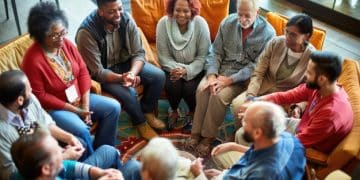Aging Population’s Impact: US Public Health & Geriatric Care Needs

The Public Health Implications of the Aging Population: Addressing the Growing Need for Geriatric Care in the US examines the escalating demand for geriatric care due to the increasing elderly population and its profound effects on public health systems within the United States.
The greying of America presents significant challenges for public health. The public health implications of the aging population: addressing the growing need for geriatric care in the US is becoming increasingly crucial as the number of older adults rises, impacting healthcare infrastructure, workforce demands, and overall community wellbeing. How can the US effectively meet the complex health needs of its aging citizens?
Understanding the Demographic Shift: The Aging Trend in the US
The United States is experiencing a significant demographic shift, with a rapidly increasing aging population. This trend presents unique challenges and opportunities for public health, requiring proactive and innovative strategies to address the healthcare needs of older adults.
The Numbers Behind the Trend
According to the U.S. Census Bureau, the number of Americans aged 65 and older is projected to nearly double from 52 million in 2018 to 95 million by 2060. This demographic transformation is driven by increased life expectancy and the aging of the Baby Boomer generation. Understanding the scale of this shift is crucial for effective public health planning.
Factors Contributing to Increased Longevity
Several factors contribute to increased longevity, including advancements in medical technology, improved sanitation, and greater access to healthcare. Public health initiatives focused on preventative care, such as vaccinations and health screenings, have also played a vital role in extending lifespans. As people live longer, the demand for geriatric care services increases exponentially.
- Advancements in medical technology leading to better treatments for chronic diseases.
- Public health campaigns promoting healthier lifestyles and preventative care.
- Improved access to healthcare services, especially for acute conditions.
- Better sanitation and nutritional practices contributing to overall health.
Consequently, the aging population is no longer a distant future concern but a present reality that demands immediate attention and comprehensive planning from public health officials and healthcare providers alike.
Defining Geriatric Care: Meeting the Unique Needs of Older Adults
Geriatric care is a specialized branch of healthcare that focuses on the unique needs of older adults. It encompasses a holistic approach to managing health issues that commonly affect seniors, including chronic diseases, cognitive impairments, and functional limitations. Understanding geriatric care is essential for addressing the health challenges posed by an aging population.
The Scope of Geriatric Care
Geriatric care extends beyond traditional medical treatments to include aspects such as mental health support, social services, and rehabilitative therapies. The goal is to enhance the quality of life for older adults by helping them maintain independence, manage chronic conditions, and navigate the complexities of aging.
Effective geriatric care requires a multidisciplinary team of healthcare professionals, including physicians, nurses, social workers, and therapists. This collaborative approach ensures that all aspects of an older adult’s health and wellbeing are addressed comprehensively.
Key Components of Geriatric Care
Geriatric care encompasses various components, each tailored to meet the specific needs of older adults. These include:
- Comprehensive Assessment: Evaluating physical, cognitive, and psychosocial health.
- Chronic Disease Management: Developing strategies to manage conditions such as diabetes, heart disease, and arthritis.
- Medication Management: Ensuring safe and effective medication use to minimize side effects and interactions.
- Rehabilitative Services: Providing therapies to improve mobility, strength, and function.

By providing specialized and comprehensive care, geriatric services can significantly improve the health outcomes and quality of life for the aging population, reducing hospitalizations and promoting independent living.
The Impact on Public Health Infrastructure: Strain and Adaptation
The escalating aging population is placing considerable strain on the public health infrastructure. Healthcare systems are struggling to adapt to the increasing demand for geriatric services, leading to workforce shortages, overburdened facilities, and rising healthcare costs.
Workforce Shortages in Geriatric Care
One of the most pressing challenges is the shortage of healthcare professionals trained in geriatric care. This shortage includes geriatricians, nurses, and other specialists who are equipped to address the complex health needs of older adults. Without an adequate workforce, the quality of care for seniors is at risk.
Adapting Healthcare Facilities and Services
Healthcare facilities need to adapt to the specific needs of older adults, including designing age-friendly environments, implementing telehealth services, and integrating geriatric care into primary care settings. These adaptations require significant investments and strategic planning.
Public health agencies play a critical role in coordinating these efforts, developing policies, and allocating resources to support geriatric care initiatives.
The Economic Burden of Geriatric Care
The economic burden of geriatric care is substantial, with rising healthcare costs and increasing demands on government resources. Medicare and Medicaid, the primary sources of funding for geriatric care, are facing financial pressures due to the growing number of beneficiaries. Innovative funding models and cost-effective care strategies are needed to ensure the sustainability of geriatric care services.
As the aging population continues to grow, addressing these challenges is crucial for ensuring that older adults have access to the high-quality, affordable care they need to maintain their health and wellbeing.
Strategies for Improvement: Enhancing Geriatric Care in the US
To address the growing need for geriatric care, the United States must implement comprehensive strategies to enhance the capacity and quality of geriatric services. These strategies include workforce development, innovative care models, and policy reforms.
Workforce Development Initiatives
Investing in workforce development is essential for building a robust geriatric care system. This includes offering scholarships and training programs to attract more healthcare professionals to the field, as well as providing continuing education opportunities for existing providers to enhance their geriatric care skills. Telehealth training is also increasingly used to improve geriatric care.
Innovative Care Models
Innovative care models, such as integrated care systems and community-based programs, can improve the efficiency and effectiveness of geriatric care. Integrated care systems coordinate care across different settings, ensuring that older adults receive seamless and comprehensive services. Community-based programs, such as adult day care and home healthcare, provide support and services that enable seniors to remain independent and engaged in their communities.

Technology plays a crucial role in enhancing geriatric care. Telehealth services, remote monitoring devices, and electronic health records can improve access to care, enhance communication between providers and patients, and promote better health outcomes.
Policy and Regulatory Reforms
Policy and regulatory reforms are needed to support the expansion and improvement of geriatric care. This includes increasing funding for geriatric research and training programs, implementing policies that promote age-friendly healthcare environments, and strengthening regulations to ensure the quality and safety of geriatric services. Supporting policies is an important step in bolstering geriatric care in the US.
The Role of Technology in Geriatric Care: Telehealth and Remote Monitoring
Technology is revolutionizing geriatric care, offering innovative solutions to improve access to care, enhance communication, and promote better health outcomes. Telehealth and remote monitoring are two key technologies transforming the delivery of geriatric services.
Benefits of Telehealth in Geriatric Care
Telehealth allows healthcare providers to deliver care remotely using video conferencing, phone consultations, and other digital tools. This technology is particularly beneficial for older adults who have difficulty traveling to healthcare facilities due to mobility issues or geographic barriers. Telehealth can also improve access to specialty care, reduce hospital readmissions, and enhance medication adherence.
Remote Monitoring Technologies
Remote monitoring devices, such as wearable sensors and home-based monitoring systems, enable healthcare providers to monitor patients’ health status remotely. These devices can track vital signs, activity levels, sleep patterns, and other health indicators, providing valuable data for early detection of health issues and personalized care planning. Through technology, healthcare is becoming easier to access.
- Improved access to care for older adults in rural or underserved areas.
- Enhanced communication between healthcare providers and patients.
- Reduced hospital readmissions through proactive monitoring and intervention.
- Personalized care plans based on real-time health data.
By embracing technology, the geriatric care system can become more efficient, accessible, and patient-centered, improving the health and wellbeing of older adults across the country.
Creating Age-Friendly Communities: Supporting Healthy Aging
Creating age-friendly communities is essential for supporting healthy aging and promoting the wellbeing of older adults. Age-friendly communities are designed to be inclusive, accessible, and supportive, enabling seniors to remain active, engaged, and independent.
Characteristics of Age-Friendly Communities
Age-friendly communities encompass eight key domains, as identified by the World Health Organization (WHO): outdoor spaces and buildings, transportation, housing, social participation, respect and social inclusion, civic participation and employment, communication and information, and community support and health services.
Examples of age-friendly initiatives include:
Community Support and Health Services
Providing access to comprehensive health services, including geriatric care, preventative care, and mental health support, is essential for promoting healthy aging. Age-friendly communities also offer community support services, such as caregiver resources, senior centers, and volunteer opportunities, which enhance social connections and promote overall wellbeing.
- Accessible public transportation options for older adults.
- Affordable and age-appropriate housing options.
- Community centers offering social and recreational activities.
- Volunteer opportunities for seniors to remain engaged and active.
By creating age-friendly environments, communities can empower older adults to live fulfilling lives, contributing to a healthier and more vibrant society.
| Key Point | Brief Description |
|---|---|
| 👴 Aging Population | The US population is rapidly aging, increasing demand for geriatric care. |
| 🏥 Geriatric Care | Specialized care for older adults, addressing health and social needs. |
| 🩺 Workforce Shortage | There is a lack of geriatric healthcare professionals to meet demand. |
| 🌐 Age-Friendly Communities | Creating inclusive, accessible communities for healthy aging. |
Frequently Asked Questions (FAQ)
▼
Geriatric care is specialized healthcare for older adults, focusing on their unique health and social needs. It includes managing chronic diseases, promoting independence, and enhancing overall wellbeing. Geriatric care often involves a multidisciplinary team of healthcare professionals.
▼
Geriatric care is crucial due to the increase in the aging population, who often require specialized medical attention. It helps older adults maintain their health, manage chronic conditions, and improve their quality of life. Proper geriatric care reduces hospitalizations and supports independent living.
▼
Key challenges include workforce shortages, rising healthcare costs, and adapting healthcare infrastructure to meet the needs of older adults. Access to care in rural areas and managing complex health conditions are also significant hurdles in geriatric care.
▼
Technology enhances geriatric care through telehealth, remote monitoring devices, and electronic health records. These tools improve access to care, enhance communication between providers and patients, and enable personalized care plans based on real-time health data, thus promoting better health outcomes.
▼
An age-friendly community is designed to be inclusive, accessible, and supportive for older adults. These communities offer services and infrastructure that promote active aging, social engagement, and independent living, and address the unique needs of older residents through various community programs.
Conclusion
Addressing the public health implications of the aging population and the growing need for geriatric care in the US requires comprehensive strategies. By investing in workforce development, promoting innovative care models, implementing supportive policies, and creating age-friendly communities, the United States can ensure that older adults receive the high-quality, affordable care they need to thrive.





